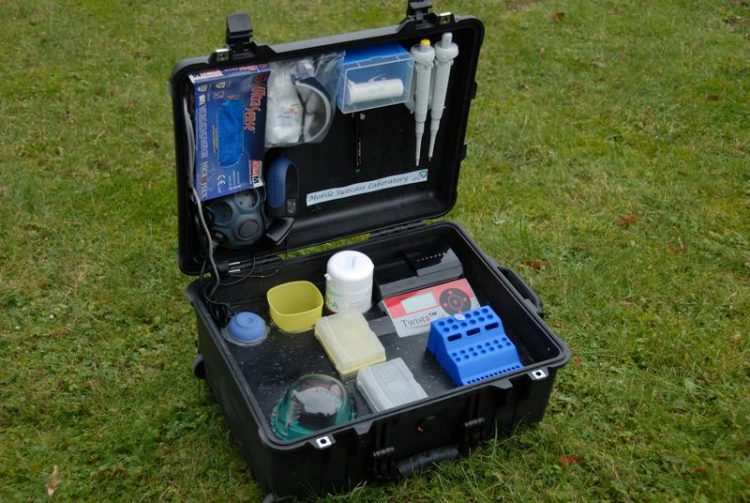DPZ-Researchers develop suitcase laboratory for rapid detection of the Ebola virus

The suitcase laboratory to detect ebola, innovated by Dr. Ahmed Abd El Wahed, infection researcher at the German Primate Center (DPZ) in Goettingen. Photo: Karin Tilch
No electricity, no reliable cold chain, no diagnostic equipment available – scientists in field laboratories who diagnose and deal with Ebola infections often work under challenging conditions. Researchers at the DPZ have developed Diagnostics-in-a-Suitcase, which contains all reagents and equipment to detect the Ebola virus within 15 minutes at point-of-need.
Moreover, the mobile suitcase laboratory will be operated by an integrated solar panel and a power pack. The mobile suitcase laboratory will enter a field trial in Guinea in collaboration with the Institut Pasteur de Dakar, Senegal, the Public Health Institute of Guinea, the University of Stirling, Robert Koch Institute, and TwistDx Ltd. Dr. Ahmed Abd El Wahed, scientist in the Unit of Infection Models at the DPZ, is the innovator of the suitcase laboratory. He will assemble five suitcases, which will be used at the Ebola treatment Centres in Guinea during the current outbreak.
Current tests rely on the detection of Ebola genome by the real-time polymerase chain reaction (PCR) technique which is not suitable for on-site screening. Samples collected from the site of an outbreak are therefore transported over long distances to laboratories for testing. Recently, criminals have stolen a motor vehicle, which transported infected material. The fear is that this might cause a wider spread of the virus if the material is used for political motives.
The Diagnostics-in-a-Suitcase will prevent this by allowing the detection of the Ebola virus at the point-of-need (not only in rural areas, but also at airports or quarantine stations). The Diagnostics-in-a-Suitcase is based on the Recombinase Polymerase Amplification (RPA) technology developed by TwistDx Ltd, a subsidiary of Alere Inc. RPA is as sensitive as PCR, but extremely rapid and works at a constant temperature, meaning no rapid heat-cycling equipment is required. Furthermore, reagents used in the RPA test are cold chain independent, which allows them to be used and transported at ambient temperature.
„The early detection of Ebola infected patients will lead to a more effective virus control since medical staff can identify and isolate confirmed Ebola cases more rapidly “, said Dr. Christiane Stahl-Hennig, the Head of the Unit of Infection Models.
„In remote field hospitals, resources such as electricity and cold storage are often in short supply.“, added Dr. Ahmed Abd El Wahed, „The Diagnostics-in-a-Suitcase will therefore contribute to a better management during the Ebola-outbreak“. From 216 applications, this project was one of six selected for funding by the British Enhancing Learning and Research for Humanitarian Assistance (ELRHA) hosted by Save the Children Fund as part of the Research for Health in Humanitarian Crisis (R2HC) programme.
Information for Journalists
Dr. Ahmed Abd El Wahed will happily demonstrate the Diagnostics-in-a-suitcase to journalists at the DPZ until January 14th.
Printable pictures are available in our Mediathek. Please send a proof in case of publication.
Contact
Dr. Ahmed Abd El Wahed
Tel.: +49 551 3851-295
E-Mail: abdelwahed@dpz.eu
Christian Kiel (Communications)
Tel.: +49 551 3851-424
E-Mail: ckiel@dpz.eu
The German Primate Center (DPZ) – Leibniz Institute for Primate Research conducts biological and biomedical research with primates in infection research, neuroscience and primate biology. The DPZ maintains three field stations in the tropics and is the reference and service center for all aspects of primate research. The DPZ is one of 89 research and infrastructure facilities of the Leibniz Association.
Media Contact
All latest news from the category: Medical Engineering
The development of medical equipment, products and technical procedures is characterized by high research and development costs in a variety of fields related to the study of human medicine.
innovations-report provides informative and stimulating reports and articles on topics ranging from imaging processes, cell and tissue techniques, optical techniques, implants, orthopedic aids, clinical and medical office equipment, dialysis systems and x-ray/radiation monitoring devices to endoscopy, ultrasound, surgical techniques, and dental materials.
Newest articles

First-of-its-kind study uses remote sensing to monitor plastic debris in rivers and lakes
Remote sensing creates a cost-effective solution to monitoring plastic pollution. A first-of-its-kind study from researchers at the University of Minnesota Twin Cities shows how remote sensing can help monitor and…

Laser-based artificial neuron mimics nerve cell functions at lightning speed
With a processing speed a billion times faster than nature, chip-based laser neuron could help advance AI tasks such as pattern recognition and sequence prediction. Researchers have developed a laser-based…

Optimising the processing of plastic waste
Just one look in the yellow bin reveals a colourful jumble of different types of plastic. However, the purer and more uniform plastic waste is, the easier it is to…



